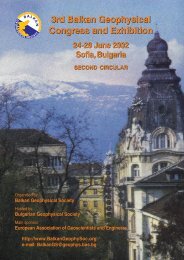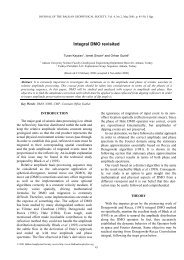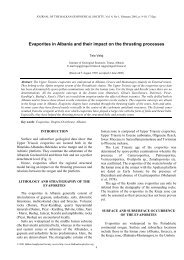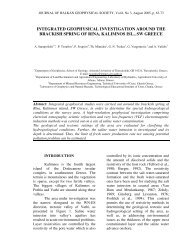Application of inverse ray-tracing seismic modelling techniques
Application of inverse ray-tracing seismic modelling techniques
Application of inverse ray-tracing seismic modelling techniques
You also want an ePaper? Increase the reach of your titles
YUMPU automatically turns print PDFs into web optimized ePapers that Google loves.
<strong>Application</strong> <strong>of</strong> <strong>inverse</strong> <strong>ray</strong>-<strong>tracing</strong> <strong>seismic</strong> <strong>modelling</strong> <strong>techniques</strong> ... 109<br />
N<br />
60 70 80 90 100 110 120 130 140 150 160 170 180 190 200 210 220 230 240<br />
S<br />
20<br />
10<br />
0<br />
0.3 1.3 2.3 3.3 4.3<br />
Km/s<br />
FIG. 3. Velocity structure <strong>of</strong> the refraction pr<strong>of</strong>ile IKRP1. Triangles denote geophone positions.<br />
FIG. 4. Top: The first arrival <strong>ray</strong>-paths through a two-layer model <strong>of</strong> IKRP1. Bottom: Comparison <strong>of</strong> observed (bars<br />
represent ±1.2 ms uncertainty) and predicted travel times shown by dots. Overall RMS misfit was 1.18 ms for 288 arrivals.<br />
layered model. This initial model is improved by the implementation<br />
<strong>of</strong> an automatic inversion procedure based<br />
on a <strong>ray</strong>-<strong>tracing</strong> technique. In particular, a set <strong>of</strong> travel<br />
times are calculated by the program, and compared with<br />
the observed data and if the misfit is not within a userspecified<br />
limit, the refractor interface is adjusted in a<br />
such way to improve the model travel times fitting. The<br />
procedure is iterative and is continued until the limit<br />
was reached. The resulted model is finally smoothed.<br />
The program Rayinvr (Zelt and Smith, 1992; Zelt and<br />
Forsyth, 1994) was implemented for the reprocessing<br />
<strong>of</strong> the data. This is a <strong>ray</strong>-<strong>tracing</strong> algorithm accompanied<br />
with a least-square inversion routine that uses any type<br />
<strong>of</strong> <strong>seismic</strong> wave arrivals and provides a simultaneous<br />
determination <strong>of</strong> the 2-D velocity and interface structure.<br />
It uses a layered model consisted <strong>of</strong> trapezoids cells. The<br />
user defines the number and the shape <strong>of</strong> the trapezoid<br />
cells and also sets the velocity values on their corners.<br />
This definition is done by setting up the respective<br />
“boundary” and “velocity nodes”. The velocity values<br />
within the trapezoids come from a linear interpolation<br />
between the four defined corner velocities. The algorithm<br />
not only improves the time required for data processing<br />
in comparison to the forward <strong>modelling</strong> but also<br />
estimates model parameter resolution, uncertainty and<br />
non-uniqueness. The Rayinvr has been mostly used in<br />
crustal studies such as those reported by Zelt and Ellis<br />
(1989); O’Leary, et al. (1995); Zelt and White (1995);<br />
Clowes, et al.,(1995); and Sato and Kennett (2000). The<br />
data processing was done on a Sun Ultra 10 workstation.








